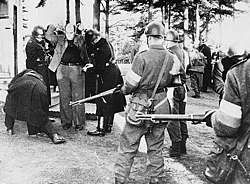Swedish extradition of Baltic soldiers
The Swedish extradition of Baltic soldiers, in Sweden known as the Extradition of the Balts (Swedish: Baltutlämningen), is a controversial political event that took place in 1945–1946, when Sweden extradited some 150 Latvian and Estonian Waffen-SS volunteers and conscripts who had been drafted and recruited by Germany to fight against the Soviet Union during World War II.

Background and extradition process
On 2 June 1945, the Soviet Union demanded that Sweden extradite all Axis soldiers. The government protocol from 15 June was kept secret until it became public on 19 November. It was supported by most of the parliament and the Swedish Communist Party wanted to go further, by extraditing all civilian refugees from Estonia, Latvia, and Lithuania.
The majority of the Baltic soldiers extradited were Latvians who had escaped from the Courland Pocket. When they reached Sweden, those in uniform were detained in detention camps. The extradition to the Soviet Union took place on 25 January 1946 in the port of Trelleborg for transportation on the steamer Beloostrov. On return they were briefly put in a camp in Liepaja and later released. According to one source at least 50 of the Latvians were arrested between 1947 and 1954 and were sentenced, often to 10–15 years in prison.[1]
Sweden also extradited about 3,000 German soldiers, according to laws on prisoners of war. The people from the Baltic states were however more controversial since the Soviet authorities viewed them as Soviet citizens (the Soviet Union had occupied the independent Baltic states in 1940) and therefore regarded the people from the Baltic states as traitors, and the internees feared death sentences. Two Latvian officers committed suicide.
Of the prisoners, Lieutenant Colonel Kārlis Gailītis and Captain Ernsts Keselis were sentenced to death but had their sentences changed to 17 years hard labour. Three others of lower ranks were sentenced to death and executed in 1946.[2]
Subsequent events
In 1970, Johan Bergenstråhle made a film, A Baltic Tragedy, about the subject. The film is based on Per Olov Enquist’s Legionärerna: En roman om baltutlämningen (1968) (English title: The Legionnaires: A Documentary Novel) which had won the Nordic Council's Literature Prize and Enquist collaborated on the script.
On 20 June 1994, 40 of the 44 surviving extradited (35 Latvians, 4 Estonians, and 1 Lithuanian) accepted an invitation to visit Sweden. They were received by King Carl XVI Gustaf of Sweden at the Royal Palace in Stockholm. The Swedish Minister of Foreign Affairs Margaretha af Ugglas said that the Swedish government agreed with the criticism of the decision and regretted the injustice.[3]
A memorial, "stranded refugee ship" (1999–2000) by Christer Bording, has been erected in Trelleborg.[4][1]
See also
References
- Flyktingminnesvård i Trelleborg Archived 2003-03-16 at the Wayback Machine. In: Fritt Militärt Forum, No. 1 (2000).
- "Baltutlämningen skildrad av de utlämnade". Archived from the original on 2011-11-17. Retrieved 2012-05-14.
- See Svenska Dagbladet 21 and 22 June 1994, and Dagens Nyheter 21 and 22 June 1994
- "Strandad flyktingbåt", at Christer Bording website
Literature
- Freivalds, O., Alksnis, E. Latviešu kaŗavīru traģēdija Zviedrijā. Copenhagen, Denmark: Imanta, 1956 (254 pp).
- Freivalds, O. De internerade balternas tragedi i Sverige år 1945-1946. Stockholm, Sweden: Daugavas vanagi, 1968 (432 pp).
- Landsmanis, A. De misstolkade legionärerna. Stockholm, Sweden: The Latvian National Foundation, 1970 (83 pp). (– Corrects Enquist’s The Legionnaires).
- Zalcmanis, J. Baltutlämningen 1946 i dokument. Stockholm, Sweden: Militärhistoriska förlaget, 1983 (96 pp).
- Ekholm, C. Balt- och tyskutlämningen 1945-1946. Uppsala, Sweden: Acta Universitatis Upsaliensis, Studia Historica Upsaliensia 136 (224 pp.), 137 (444 pp.), 1984.
- Ekholm, C. & Schulze, H. Flyktingminnesvård i Trelleborg. Fritt Militärt Forum Nr 1, 2000.
- Silamiķelis, V. With the Baltic Flag (ISBN 9984055590). Rīga, Latvia: Jumava, 2002 (316 pp).